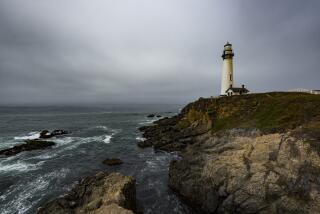Driving to the Sun in Glacier Park
A sign for Glacier County was posted by the highway in northwestern Montana, but there was no ice in sight on that September morning. Even shade was scarce on those vast, high plains of big holdings and small communities.
From Bynum to Browning, the land spread out like a rumpled mat before the Rocky Mountain wall--miles of tawny stubble where wheat fields had stood before the threshers came. From the top of a knoll, you could see a lone slash of green--the mark of a river, and maybe a ranch.
This was Blackfeet tribal country. At the edge of Browning was a billboard: âWelcome to the home of Indian Pride.â
Pickup trucks, their radios blasting, crowded the self-serve gas station. A friend and I were heading for a loop through the mountain fastness of Glacier National Park, so we decided to join the line.
Images flashed along the main street: TeePee Auto Parts. The Warbonnet Lodge motel. Northern High Plains Outfitters. A sign, âTribal Permits for Guided Fishing.â Western Curios. Blackfeet Trading Post. A liquor store named Ickâs Place.
Holding down the western edge of town was the two-story, red-brick Museum of the Plains Indians. Despite its fine reputation, we did not stop because of the miles ahead.
We scanned on the car radio and picked up station KMON from Havre, a lonesome hub to the east that the disk jockey kept calling the âelectric city.â Her patter was informal. She interrupted the local weather report to yelp: âOooh, I just got hair in my mouth . . . Donât you just hate that!â
Northwest of Browning, the land began to tilt and turn green. Forests of birch and ponderosa pines led to the Glacier National Park entrance at St. Mary. Itâs 46 miles from there to Glacierâs Canadian link--Waterton Lakes National Park. Feeling a little hungry, we stopped at St. Mary Lodge for ice cream with a favored local topping: fresh huckleberries.
Then onward and upward. Glacier Park rises in horizontal chunks, its monumental mountains streaked with shale and limestone, shadowy ledges, hanging gardens. In the angular stones it is not hard to imagine Mayan temples.
The park looms big in Big Sky Country: more than a million acres of craggy mountains, alpine lakes, almost a thousand miles of hiking trails, bighorn sheep, mountain goats, moose, elk and bears. Plus 50 glaciers.
The majestic Going-to-the-Sun Highway is the only through-road. This 50-mile-long wonder crosses the Continental Divide at Logan Pass (6,646 feet). Vehicles longer than 35 feet are not allowed. A spur from the eastern slope town of Babb leads to Many Glacier Hotel, a Swiss-style inn built in 1914 on the shores of Swiftcurrent Lake.
Before, when I had traveled over Going-to-the-Sun, it had been in early June. The adventure was an etching in white-on-gray: deep snowbanks, heavy waterfalls, muted sun.
In September it was a warmer world. The wildflowers were at their peak, dappling the roadsides and alpine meadows with gold and magenta. Wide green swaths on the sunny slopes turned out to be avalanche paths. Crowds were beginning to thin as the lodges prepared to close for the winter.
The early days of Glacier Park chugged to mind with each sighting of the bright red, open-top touring vans built by the White Motor Co. in 1936. The first fleet went into service in 1914, when horse-drawn carriages were retired.
From June through September, these 16-passenger vans make day trips among the park lodges, including the venerable Glacier Park Lodge at East Glacier, near a flower-bound Amtrak station. We stopped there for afternoon tea.
The lobby is a forest of pillars--whole trunks of Douglas fir rise 40 feet, ruddy bark intact. When the lodge opened in 1913, scores of Blackfeet pitched teepees on the hotel grounds and danced in celebration. The Indians named the place âOom-Coo-La-Mush-Taw,â which was translated as âBig Tree Lodge.â
At the far end of the lobby, a man in a Hawaiian shirt sat at the piano and began playing a repertoire of allegiances: âAmerica the Beautiful,â âHome on the Range,â âDixie,â âThe Battle Hymn of the Republic,â âO Canada.â A white-haired woman of elegant posture and porcelain skin paused on the second balcony. Her eyes glistened as the man began playing âWhen I Grow Too Old to Dream.â
The sun was getting low. We had promised to get back to a ranch near Choteau in time for a party. We had 90 miles to go, but then some of the âneighborsâ would be driving at least that far each way.
On that star-spangled night, I swapped stories with an 87-year-old piano teacher who asked what direction we had driven through the park.
âFrom east to west,â I replied.
She shook her head. âItâs much more spectacular if you go in from the west--the drama builds better, you see entirely different views. Well, next time youâll know.â
I thought of the eye-of-the-beholder and of the park rangerâs tale of Swiss tourists who nodded all the way over Going-to-the-Sun Highway from West Glacier.
âBut when they looked out and saw the eastern plains, they yelled âStop!ââ the ranger recalled. âThey went wild. They took a million pictures. Mountains and glaciers were old hat, but they had never seen so much wide, open space. This was the American West they were looking for.â
More to Read
Sign up for The Wild
Weâll help you find the best places to hike, bike and run, as well as the perfect silent spots for meditation and yoga.
You may occasionally receive promotional content from the Los Angeles Times.






